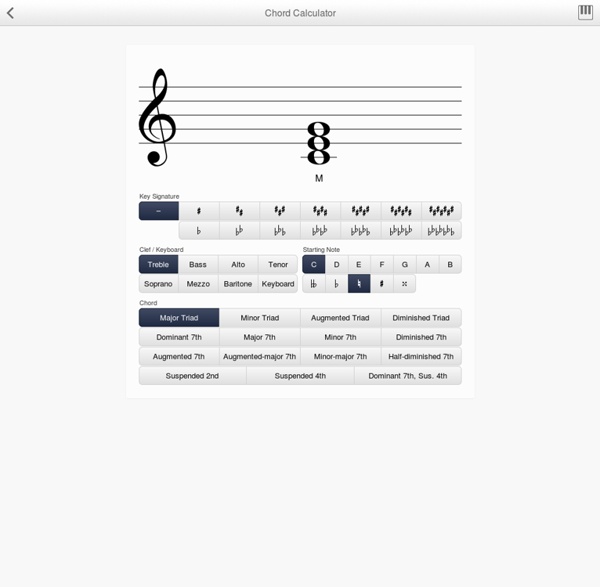Free Music Theory Worksheets!
Material on this page is free.NEW! you can now consult an index of terms used in these worksheets.Also explore a page of worksheet extras: Worksheet Answers, Test Templates and Flash Presentations. Here are some testimonials from music teachers about these workbook chapters: I have been using your fantastic music theory sheets and PDF downloads to teach high school piano theory to 28 students per class, all of whom are at different levels of study and accomplishment.
Learn Guitar Scales with Chordbook
Message for visitors on Mobile or small tablet. The guitar app on this page is currently a mobile demo. Enjoy the full app on a larger screen. Scales are groups of notes ordered by pitch or frequency, either going up in pitch or down. To learn guitar scales is a great way of exploring the fretboard of the guitar and finding the patterns that will help you with improvising solos and also it will increase the flexibility and strength of your fingers the more exercises you do. The very first guitar scale we recommend you learn is the minor pentatonic.
Scales and emotions
See also a post about making chords from scales. So maybe you want to write a song or an instrumental in a particular mood or style, and you’re feeling overwhelmed by all the scales. Here’s a handy guide to the commonly used scales in Western pop, rock, jazz, blues and so on. Click each image to play the scale right in your browser with the aQWERTYon. These scales have a major third (E in the key of C), which makes them feel happy or bright. Major scale
Key Chords
Key Chords app generates guitar chord progressions automatically. Use it free online, or get the app for Mac, Windows or iOS (iPad) - Click on a chord to preview how it sounds. - Drag and drop to arrange the chord progression - Tweak the settings to control the playback speed Or role the dice and Key Chords will automatically generate a nice sounding progression. Select a Key: Select a key and choose a the major or minor scale.
83 Jam Tracks For Guitar
Download all the free jam tracks now! A lot of them anyway - 83 of the jam tracks for guitar players are available here on the one page. If you want more information on each track then go to the page that the jam track is from for music theory and other information. Taken from the Blues Guitar Jam Tracks page: 01 Slow Blues In A mp3 wma 02 E Shuffle mp3 wma 03 A Straight mp3 wma 04 Eb Slow Blues (E if you play guitar and tune down 1/2 a step) mp3 wma 05 Ab Shuffle (A if you play gutar and tune down 1/2 a step) mp3 wma 06 G Medium Blues mp3 wma 07 E Fast Shuffle mp3 wma 08 A Medium Blues Shuffle mp3 wma 09 A Medium Blues Shuffle Quick Change mp3 wma 10 Eb Straight Ahead Blues (E if you play guitar and tune down 1/2 a step) mp3 wma 11 B Slow Blues (C if you play guitar and tune down 1/2 a step) mp3 wma
I analyzed the chords of 1300 popular songs for patterns. This is what I found.
For many people, listening to music elicits such an emotional response that the idea of dredging it for statistics and structure can seem odd or even misguided. But knowing these patterns can give one a deeper more fundamental sense for how music works; for me this makes listening to music a lot more interesting. Of course, if you play an instrument or want to write songs, being aware of these things is obviously of great practical importance.
Guitar Modes For Jazz Guitar (And Other Styles Of Music)
In this lesson you'll learn what the modes are, how they look on the guitar and how you can use them in your guitar solos and improvisations. Click Here To Download Your Free Jazz Guitar eBook What Are Guitar Modes? Modes are scales derived from the major scale. Modes are nothing new, the modes as we use them today were formalized around 1675.
Speak from day 1
You don’t have to be “gifted” to learn a new language, but you do have to be smart about how you learn it. Hi! When you’ve watched the video above and are ready to join the thousands of other language hackers who are using the Fluent in 3 Months PREMIUM package as an unconventional approach to learn languages quickly, click the button below. If you’ve got any questions after watching the video, check out the “Frequently Asked Questions” page. I’ve tried to answer every possible question you might have on that page, including ones I get a lot such as: “What if I’m not good at learning languages?”
Jazz Progressions
Jazz Progressions are simply common chord progressions in jazz music. One of the most common progressions is the ii-V-I progression. The ii-V-I sounds at its best when you use seventh chords and their expanded voicings. As you already know from past lessons, the ii chord is a minor chord, the V chord is a dominant chord, and the I chord is a major chord. So the most basic Jazz progression is the ii minor 7 - V dominant 7 - I major 7. In the key of C, this progression is Dm7-G7-Cmaj7.


